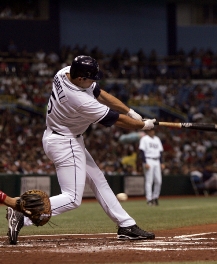Via El Birdos points out one excuse for leaving Mark McGwire off the Hall of Fame ballot: Mark excelled in only one dimension of the game. As the Cardinals blogger points out, this is simply not true.
The problem with thinking of McGwire as a one dimensional player comes from not understanding the dimensions of offense. There are really just three dimensions. (All dimensions listed in what I consider the order of importance.)
- Getting on base
- Hitting for power
- Running the bases
(Please don’t confuse ordering with weighting. The significance of base running to offense is much lower than the first two items.)
Within each of these dimensions, there are other dimensions. Think of Einstein’s four dimensional universe for a moment. There really are just two dimensions, space and time. Space, however, is made up of three dimensions, but which one of those you’re dealing with is arbitrary based on how you orient your coordinate system. Getting on base consists of three dimensions, at least ones that the batters controls:
- Collecting hits
- Drawing walks
- Getting hit by the pitch
Power contains four dimensions:
- Hitting home runs
- Hitting doubles
- Hitting triples
- Hitting singles
Base running is even more layered:
- Speed
- Judgment
- Taking the extra base (situational judgment)
- Reading the pitcher (base stealing)
Using this list of dimensions, it’s clear that at the highest level, McGwire excelled at the two most important dimensions of offense. He did an excellent job of getting on base and hitting for power. He gets no credit for his base running ability, as he had no speed, which pretty much defeated any judgment he have brought to the table.
Within the sub-dimensions of getting on base and hitting for power, however, McGwire was a low dimensional player. He owns a high OBP because of his large number of walks. His free passes represent 43.6% of his time on base. For the years 1986-2001, 26.8% of times on base were walks for the major leagues. His power derives from hitting home runs. 69.3% Of his extra base hits were home runs compared to 33.9% for the majors, and 35.9% of his hits were home runs, compared to 10.7% for the majors. McGwire was a home run hitter who walked a lot. McGwire is a one dimensional player within the two most important elements of offense, but at the highest level he’s very good at both.
Note that someone like Ichiro Suzuki is also a low dimensional offensive player, with getting on base and base running his two strongest suits. Within each of those categories, he’s mostly one dimensional as well, with collecting hits and speed being his two big assets. There’s even a great deal of overlap, as speed is a big reason he collects so many hits. Yet, he posts a lower career OBP than McGwire, and even for someone with great speed, he doesn’t hit that many doubles and triples (averages 33 doubles + triples a season). When Ichiro’s career is over, no one is going to hold his lack of extra base hits or walks against him when it comes to voting for the Hall of Fame.
There are multiple ways of being a multi-dimensional offensive ballplayer. Mark McGwire concentrated his offense into two sub-dimensions, but still emerged as someone excellent at both getting on base and hitting for power. His low hit totals should not be an excuse to avoid voting for him.

Update: The following graphs show how hits contributed to both McGwire’s and Ichiro’s offense. The height represents slugging percentage and the width OBP. The smaller, metallic colored rectangle represents the contribution of hits to each. Note that McGwire owns a wider and taller rectangle, despite a smaller contribution from hits.




